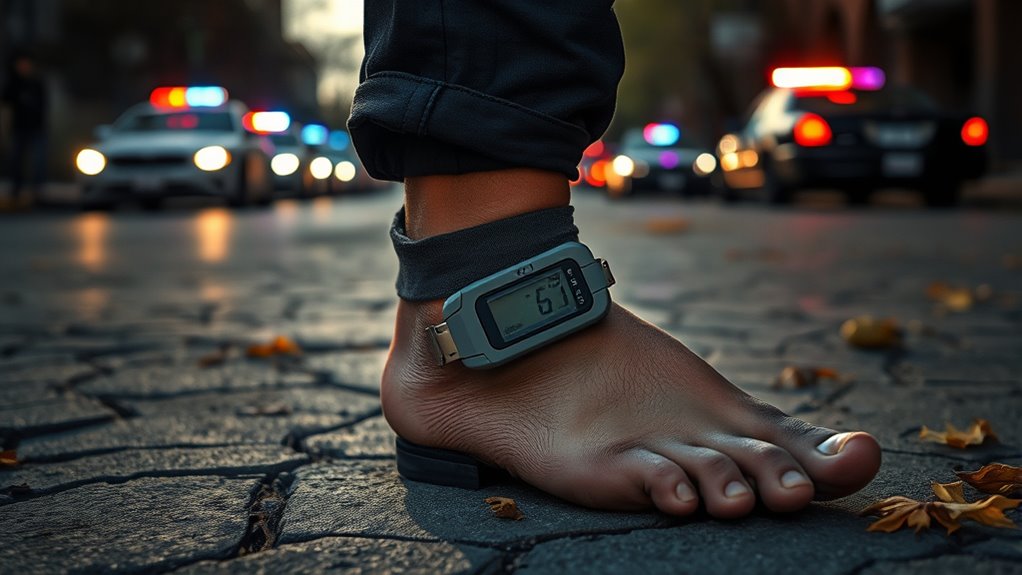Ankle monitors are typically used for non-violent offenses like drug crimes and property theft. They can also apply to certain violent crimes but under strict conditions, such as evaluating reoffending risks for assault or ensuring victim safety in domestic violence cases. Courts may grant pre-trial monitoring for serious cases like homicide. This approach aims to balance public safety and rehabilitation. Exploring the implications of such monitoring can reveal more about its effectiveness and ethical considerations.
Overview of Ankle Monitoring in the Criminal Justice System
Ankle monitoring has become an increasingly common tool in the criminal justice system, especially as alternatives to incarceration gain traction. This technology allows authorities to track individuals’ movements through GPS or radio frequency methods, providing a way to supervise offenders while they remain in the community. However, this brings up important questions regarding surveillance privacy. You might wonder how much of your personal freedom is compromised for the sake of monitoring. While ankle monitors can reduce overcrowding in jails and offer a second chance to many, they also raise concerns about the potential for misuse and overreach by law enforcement. Ultimately, it’s essential to balance public safety with individual rights, ensuring that technology serves justice without infringing on personal liberties.
Non-Violent Offenses and Ankle Monitors
While many associate ankle monitors with serious criminal offenses, they’re increasingly utilized for non-violent crimes, reflecting a shift in how the justice system approaches rehabilitation. For individuals charged with drug offenses, these monitors offer an alternative to incarceration, allowing them to maintain employment and family connections while addressing their substance use issues. Similarly, property crimes, such as theft or vandalism, often lead to ankle monitoring as a way to guarantee accountability without resorting to imprisonment. This approach not only reduces overcrowding in jails but also supports reintegration into society. By focusing on non-violent offenders, the system aims to balance public safety with the opportunity for personal reform, paving the way for a more compassionate and effective justice process.
Violent Crimes That May Lead to Ankle Monitoring
Although ankle monitors are often linked to non-violent offenses, they can also be applied in cases involving violent crimes under specific circumstances. For instance, individuals facing assault charges or even certain homicide cases may find themselves wearing these devices as part of their bail conditions or sentencing alternatives. Courts may decide to implement ankle monitoring to balance public safety with the need for rehabilitation.
| Crime Type | Monitoring Justification |
|---|---|
| Assault Charges | Risk of reoffending |
| Homicide Cases | Pre-trial release considerations |
| Domestic Violence | Victim protection |
| Robbery | Minimizing flight risk |
| Aggravated Assault | Monitoring behavior post-release |
In these scenarios, the aim is often to provide a chance for freedom while still ensuring safety.
The Role of Recidivism in Ankle Monitor Decisions
Recidivism plays a significant role in determining whether an individual is placed under an ankle monitor, especially when violent crimes are involved. Courts often look at recidivism rates to assess the likelihood of re-offense. If you have a history of repeated offenses, it raises concerns about public safety. Ankle monitors serve as a preventive measure, aiming to deter further criminal activity. However, the effectiveness of this monitoring can vary. Some studies suggest that ankle monitors can reduce recidivism rates, while others indicate that they might not be a foolproof solution. Ultimately, the decision to impose monitoring hinges on an individual’s past behavior and the perceived risk they pose to society, balancing freedom with safety considerations.
Legal and Ethical Considerations of Ankle Surveillance
As the use of ankle monitors becomes more prevalent in the criminal justice system, it is crucial to examine the legal and ethical implications surrounding their implementation. You might wonder how these devices impact individual rights and freedoms. Privacy concerns arise as constant surveillance can feel intrusive, raising questions about the balance between public safety and personal liberty. Ethically, the potential for misuse or overreach by authorities becomes a critical issue. Are ankle monitors reinforcing systemic biases, or do they effectively reduce recidivism? Ultimately, these devices provoke a broader discussion about the fairness of surveillance measures and their long-term effects on society. Understanding these implications can help you navigate the complexities of justice and personal freedom in a monitored world.
Frequently Asked Questions
How Long Do Offenders Typically Wear Ankle Monitors?
Typically, offenders wear ankle monitors for several weeks to months, depending on monitor duration and compliance with court orders. The exact timeframe varies considerably based on individual cases and the severity of the offense.
Can Ankle Monitors Be Removed by the Wearer?
You can’t remove an ankle monitor yourself; it’s designed for offender compliance. Attempting removal might lead to legal consequences, as authorities track your movements closely. Understanding the implications is essential for maintaining your freedom.
Are Ankle Monitors Used for Pre-Trial Release?
Yes, ankle monitors are often used for pre-trial release, serving as invisible chains tethering individuals to their homes. This monitoring technology enforces pre-trial conditions while balancing public safety and the desire for personal freedom.
What Happens if an Ankle Monitor Is Tampered With?
If you tamper with an ankle monitor, you’ll face serious tampering consequences, like heightened monitoring penalties or even incarceration. Authorities take such actions seriously, viewing them as attempts to evade legal obligations.
Do Ankle Monitors Track Location in Real-Time?
Yes, ankle monitors use real-time tracking to guarantee compliance with monitoring technology. Ironically, while meant to guarantee freedom through supervision, they often remind you of the constraints imposed on your movements and choices.

